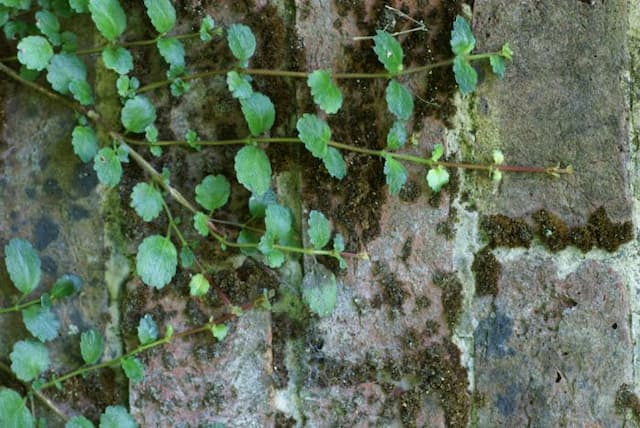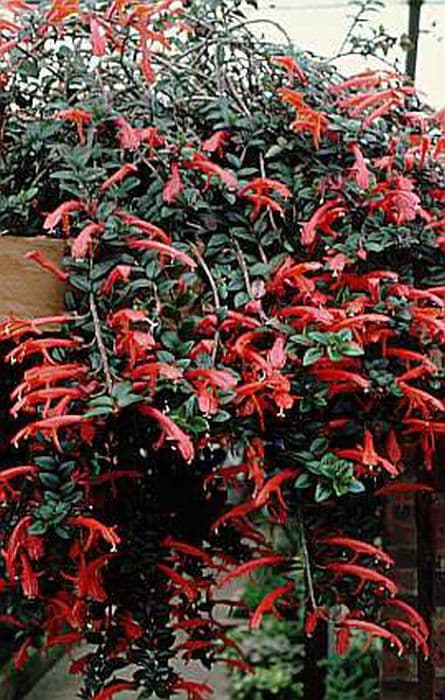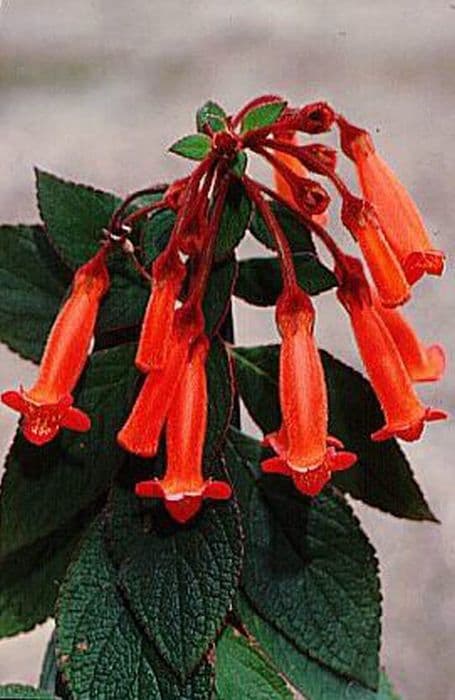Hot Water Plant Achimenes 'Little Beauty'

ABOUT
Achimenes 'Little Beauty' is a charming flowering plant known for its vibrant and profuse blooms. The appearance of this plant is highlighted by the abundance of trumpet-shaped flowers that come in a stunning shade of violet-blue, often with a white throat, giving a delightful contrast against the flower's primary color. These flowers typically possess a velvety texture, adding to the overall aesthetic of the plant. The foliage of 'Little Beauty' has an attractive quality as well, comprised of dark green leaves that provide a lush backdrop for the colorful blossoms. The leaves themselves are often soft to the touch, with a slightly hairy or fuzzy surface that many find pleasing both visually and tactilely. As a plant that is frequently grown for its ornamental value, 'Little Beauty' fits well in various settings including container gardens, hanging baskets, and as a charming addition to shaded garden beds where it creates a carpet-like effect with its dense, green foliage, and abundant flowering. This plant's ability to produce a profusion of flowers makes it a standout among other greenery, drawing the eye with its vibrant hues and appealing form.
About this plant
 Names
NamesFamily
Gesneriaceae
Synonyms
Magic Flower, Nut Orchid, Cupid's Bower, Hot Water Plant
Common names
Achimenes 'Little Beauty'
 Toxicity
ToxicityTo humans
Hot water plant, which is another common name for Achimenes 'Little Beauty', is not known to be toxic to humans. There are no significant symptoms associated with poisoning from this plant, as it is generally considered non-toxic. Therefore, ingesting parts of this plant is unlikely to lead to harmful consequences.
To pets
Hot water plant is not known to be toxic to pets. Ingesting parts of this plant should not cause any significant symptoms of poisoning in animals such as cats and dogs. It is generally considered to be a safe plant in homes with pets.
 Characteristics
CharacteristicsLife cycle
Perennials
Foliage type
Deciduous
Color of leaves
Green
Flower color
Mixed
Height
6-12 inches (15-30 cm)
Spread
6-12 inches (15-30 cm)
Plant type
Herb
Hardiness zones
10
Native area
Mexico
Benefits
 General Benefits
General Benefits- Easy to Care For: Achimenes 'Little Beauty' is relatively low-maintenance, making it ideal for beginner gardeners.
- Attracts Pollinators: Its vivid flowers can attract butterflies and hummingbirds, which are beneficial for pollination.
- Compact Size: The plant's small stature suits limited spaces like small gardens, patios, or indoor containers.
- Ornamental Appeal: It offers aesthetic value with its colorful and charming flowers, enhancing the visual interest of any garden or home.
- Adaptable: Achimenes 'Little Beauty' can adapt to various light conditions, though it thrives best in partial shade.
- Long Blooming: It has a long flowering season, providing continual bursts of color for an extended period.
 Medical Properties
Medical PropertiesThis plant is not used for medical purposes.
 Air-purifying Qualities
Air-purifying QualitiesThis plant is not specifically known for air purifying qualities.
 Other Uses
Other Uses- Fairy Gardens: Achimenes 'Little Beauty' is a small and delicate plant that can be used to create enchanting fairy garden landscapes, giving a magical appearance.
- Bridal Bouquets: Its vibrant flowers can add a romantic and colorful touch to bridal bouquets for a unique and personal floral arrangement.
- Photography Prop: The plant can be used as a photography prop to add a splash of color and natural beauty to professional photo shoots.
- Educational Tools: The plant can serve as an educational tool to teach children or students about plant care and the lifecycle of flowering plants.
- Artistic Inspiration: Artists can use Achimenes 'Little Beauty' as a subject for painting, drawing, or photography to capture its intricate details and colors.
- Bonsai Companion: This plant can serve as a suitable understory or companion plant in bonsai displays, complementing the miniature trees.
- Gift Plant: Achimenes 'Little Beauty' can be given as a gift to plant lovers for special occasions due to its attractive appearance and easy care requirements.
- Hobby Greenhouse Plant: Enthusiasts can use this plant to add diversity to their hobby greenhouse collections.
- Table Centerpieces: Small pots of the plant can be used to create lively and attractive table centerpieces for events or home decor.
- Container Plant Mix: Achimenes 'Little Beauty' can be combined with other small plants in container gardens to create a layered, textured look.
Interesting Facts
 Feng Shui
Feng ShuiThe Hot Water Plant is not used in Feng Shui practice.
 Zodiac Sign Compitability
Zodiac Sign CompitabilityThe Hot Water Plant is not used in astrology practice.
 Plant Symbolism
Plant Symbolism- Delicacy: Achimenes, known as Hot Water Plant, often symbolizes delicacy due to its tender and fine blossoms that require careful handling.
- Charm: With its bright and attractive flowers, the Hot Water Plant represents charm, alluding to its ability to captivate and enchant onlookers.
- Warmth: The common name 'Hot Water Plant' suggests a symbolism of warmth, both in its tropical origins and the cozy feelings its blooms may inspire.
- Variety: Given the diverse colors and patterns of Achimenes flowers, they can symbolize variety and diversity, celebrating differences and unique beauty.
- Resurgence: As the Hot Water Plant can re-emerge from dormancy with vibrant flowers, it can symbolize renewal or rebirth, marking new beginnings.
 Water
WaterHot Water Plant should be watered when the top inch of soil feels dry to the touch, generally every week but may vary depending on environmental conditions. Use room temperature water to gently water the soil until it is evenly moist but not soggy, and ensure excess water can drain to avoid root rot. During active growth periods in spring and summer, water about 8-16 oz weekly, and reduce watering in the fall and winter when the plant is not actively growing.
 Light
LightHot Water Plant thrives in bright, indirect light away from harsh direct sunlight which can scorch its delicate leaves. A north or east-facing window with filtered light is ideal, providing enough light to encourage flowering without causing damage.
 Temperature
TemperatureHot Water Plant prefers warm temperatures between 60°F and 75°F and should not be exposed to temperatures below 50°F as it can damage the plant. They favor consistently warm conditions without drastic fluctuations for optimal growth.
 Pruning
PruningHot Water Plant should be pruned to encourage bushier growth and remove spent flowers to promote more blooms. Trim the plant lightly after its main blooming cycle, typically in late summer or early fall, to stimulate the next season's growth.
 Cleaning
CleaningAs needed
 Soil
SoilHot Water Plant requires well-draining, fertile soil with a pH of 5.5 to 6.5. A mixture of peat, perlite, and potting soil is ideal for healthy growth.
 Repotting
RepottingHot Water Plants should be repotted every year in the spring, before the onset of the growth season.
 Humidity & Misting
Humidity & MistingHot Water Plant prefers high humidity levels, ideally between 60-80%.
 Suitable locations
Suitable locationsIndoor
Place in bright, indirect light and keep soil moist.
Outdoor
Shelter from direct sun, moist soil, and protect from frost.
Hardiness zone
10-11 USDA
 Life cycle
Life cycleThe life cycle of the Achimenes 'Little Beauty' or Cupid's Bower begins with rhizomatous tubers planted in early spring. As temperatures rise, the tubers produce stems and leaves, developing into a full foliage plant. During the growing season, typically from late spring to summer, Cupid's Bower blooms, showcasing its vibrant flowers. After flowering, the plant sets seed, and as fall approaches, the foliage begins to wither as the plant enters dormancy. The tubers remain dormant over winter, storing energy for the next growing season. With the return of warmer spring temperatures, the cycle restarts as the tubers sprout new growth.
 Propogation
PropogationPropogation time
Spring-Early Summer
Propogation: The Achimenes 'Little Beauty', commonly known as Cupid's Bower or Hot Water Plant, is most effectively propagated through division of its rhizomes. This is best done in the spring when the plant is beginning to come out of dormancy and active growth is on the horizon. Rhizomes should be carefully separated with a clean, sharp tool, ensuring that each division has at least one growing point, or ‘eye’. Once separated, the rhizomes can be planted in a well-draining potting mix, placed about an inch deep. It’s important to maintain moist but not waterlogged conditions. As the temperature rises, new growth will emerge, indicating successful propagation.









